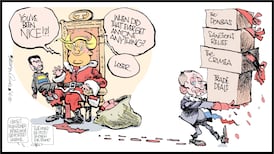The energy transition in Ireland, and in most other countries, relies on a massive increase in renewable energy investment. Renewable electricity generation has typically attracted subsidy payments because the costs of producing a unit of energy from a renewable source, such as wind or solar power, has been higher than the cost of producing a unit of energy from a fossil fuel generator – until recently.
One really good news story that has flown under the radar is the fact that the cost of renewable generation has fallen precipitously in recent years. The main metric used to compare one source of energy to another is called the Levelised Cost of Energy (LCOE). This metric is a crude one, and is increasingly irrelevant for modern power systems, but in the absence of a more comprehensive measure, it’s worth comparing the LCOEs of various technologies.
According to the International Renewable Energy Agency, the LCOE of solar power has declined by a massive 89 per cent since 2010, while the LCOEs of onshore wind, solar power and offshore wind have declined by 69 per cent, 69 per cent and 59 per cent respectively. In fact, the LCOEs of onshore wind and solar power are now lower than coal, gas or nuclear generation. This is a great development, and no one saw it coming.
The decline is partly explained by “learning curves”. As a technology is deployed, we learn more about how to do so in a cost-effective manner and can deploy further generation at lower cost. Early investors lose out – German consumers, for example, are locked into paying high subsidies for renewable power that were set at a time when renewable power costs were far higher, but the rest of us reap the benefits of cheaper prices thanks to Germany’s heavy early investment.
READ MORE
There is no policy appetite for halting our renewable energy auctions, and there is nothing Ireland can do about global supply chains and interest rates
The learning curve creates a virtuous cycle: as deployment increases, prices fall, which increases demand for renewable investment, which increases deployment. However, other political and strategic factors come into play also. China has invested heavily in solar power, driving down prices worldwide, but has also cornered the market for the production of solar panels.
These reductions in renewable power costs have been reflected in the auctions for subsidies for renewable generation in various EU countries. For the most part, prices in auctions have been falling as more auctions are held – the learning curve is at work again.
Turning to Ireland, the picture is not so rosy. We have had three onshore wind and solar auctions to date – and so far, every auction has cleared at a higher price, and with a lower volume of renewable investment being procured than the previous one. (A brief reminder of how these auctions work: firms submit bids to EirGrid for the price they are willing to generate electricity for. Contracts are awarded based on the price bid, from cheapest to most expensive. When market prices are below the guaranteed price, consumers top up the renewable energy producer; when prices are above it, the producer pays the difference back to the consumer.) Our first ever offshore auction cleared last April at a price that was far lower than expected.
The latest onshore auction did not follow suit, despite favourable changes to the terms and conditions of the auction. As interest rates increase and supply chains come under pressure, the cost of renewable energy projects may well rise even further – right at the time when we’re looking to substantially increase our investment in renewable energy.
The learning curve creates a virtuous cycle: as deployment increases, prices fall, which increases demand for renewable investment, which increases deployment
Why is it that renewable energy costs are falling worldwide, but keep increasing in Ireland? Tweaking the auction design has not helped, despite assurances from industry that it would. Delays in securing planning permission don’t help either - it has been over a year since a single wind farm has received planning permission.
There are wind farms in Ireland that have planning permission and approved grid connections, but are not entering the auctions. This is partly due to investment in renewable energy by the tech sector. Renewable projects with planning permission are signing contracts directly with tech companies, rather than entering the auction for subsidies. This is good for Irish consumers – we get the benefits of these renewable power projects without having to subsidise them – but it also means that the Government auction is stuck with the poorer, more expensive projects.
Much of this is outside our control: there is no policy appetite for halting our renewable energy auctions, and there is nothing Ireland can do about global supply chains and interest rates. Tackling the planning delays remains one of the few tools that could help reduce costs. Let’s hope it’s not too little too late.
Muireann Lynch is an economist at the Economic and Social Research Institute










